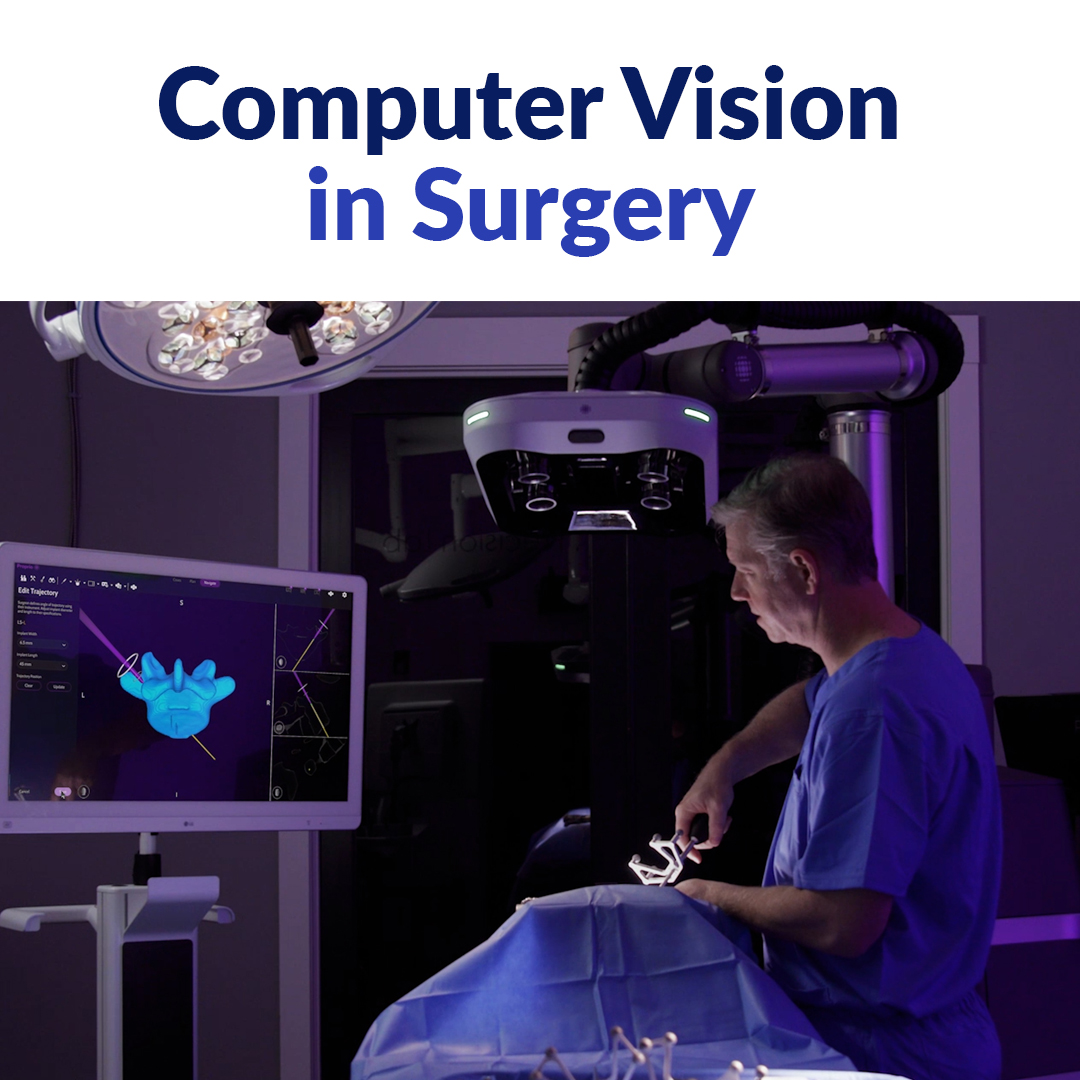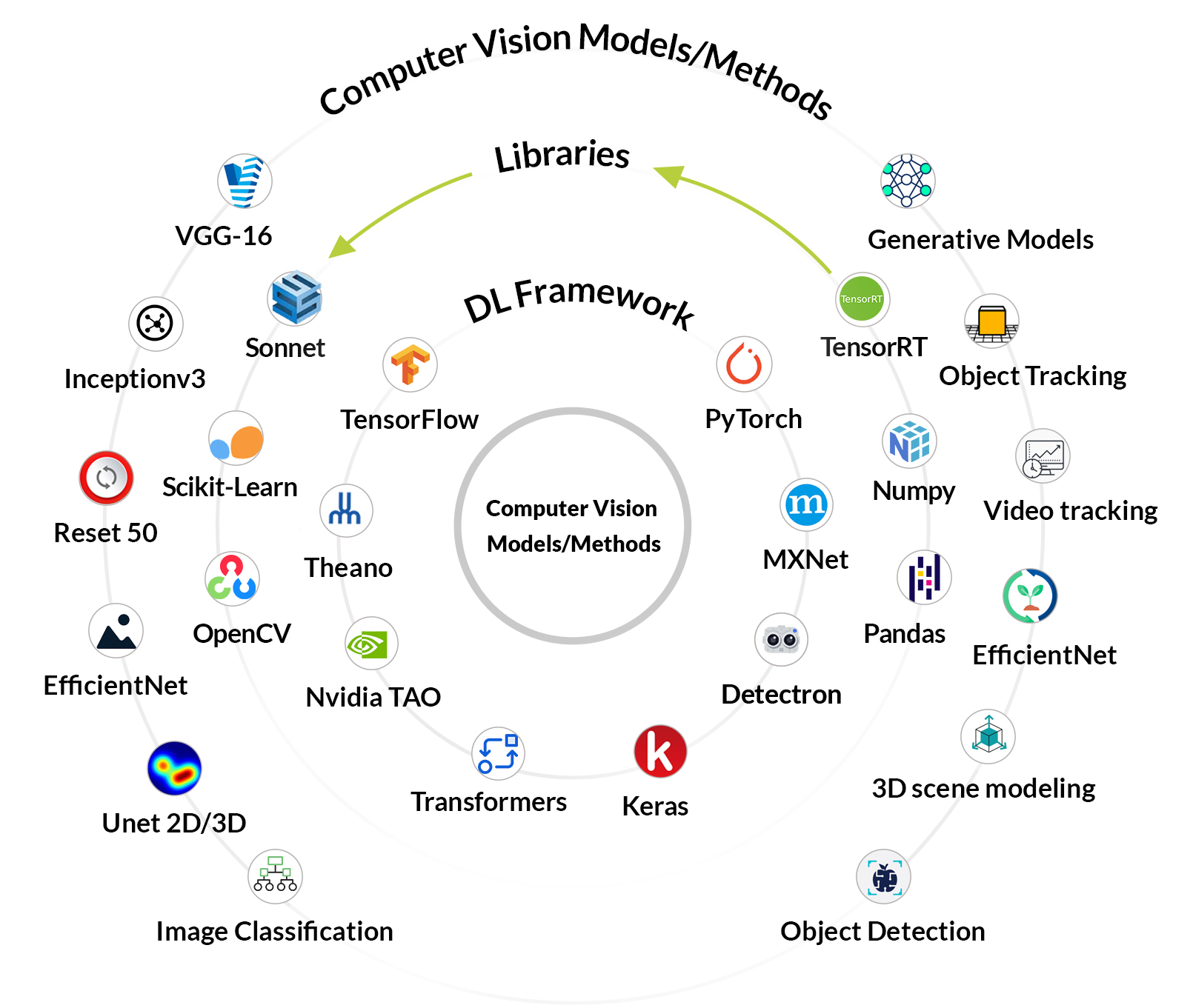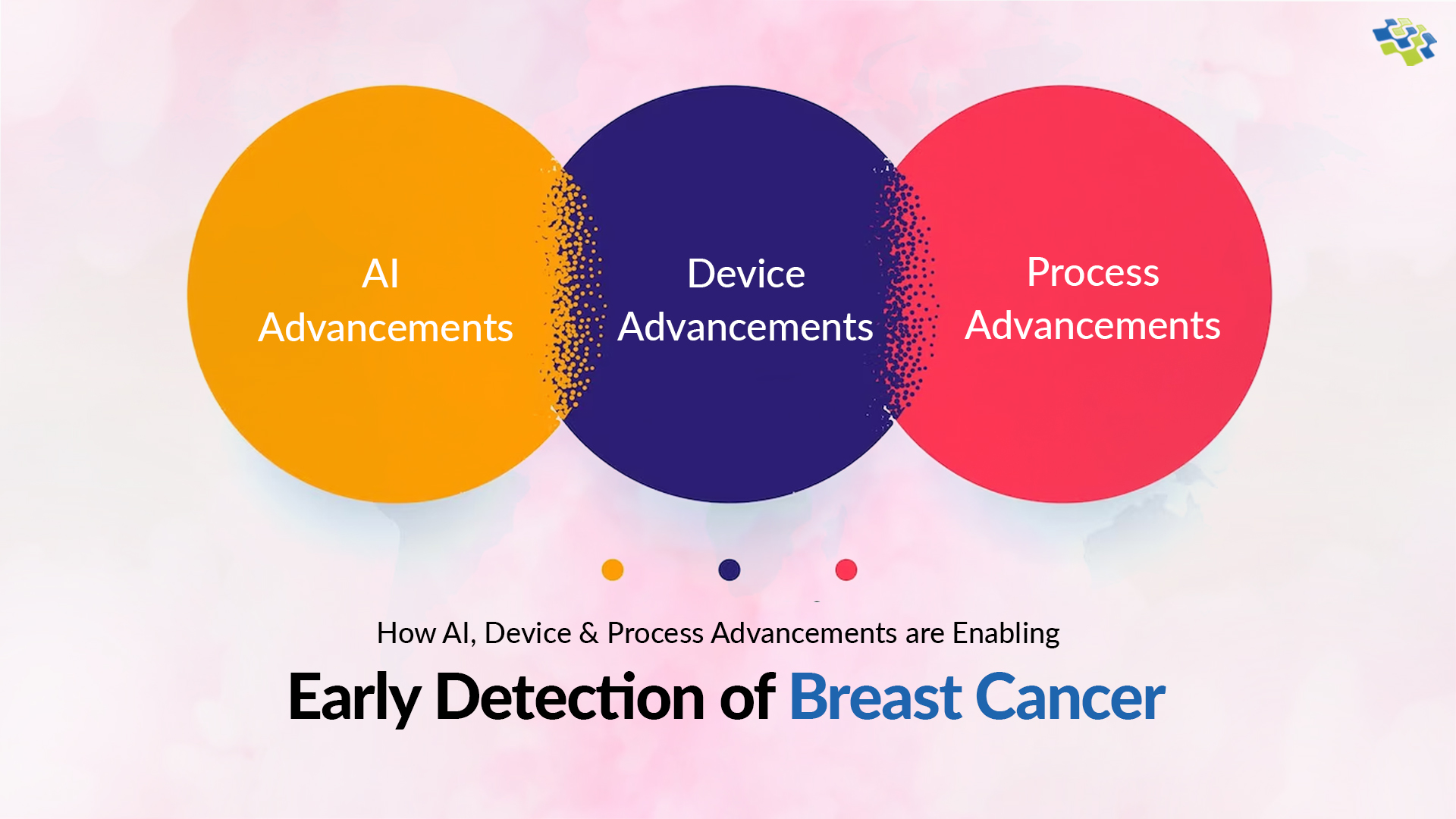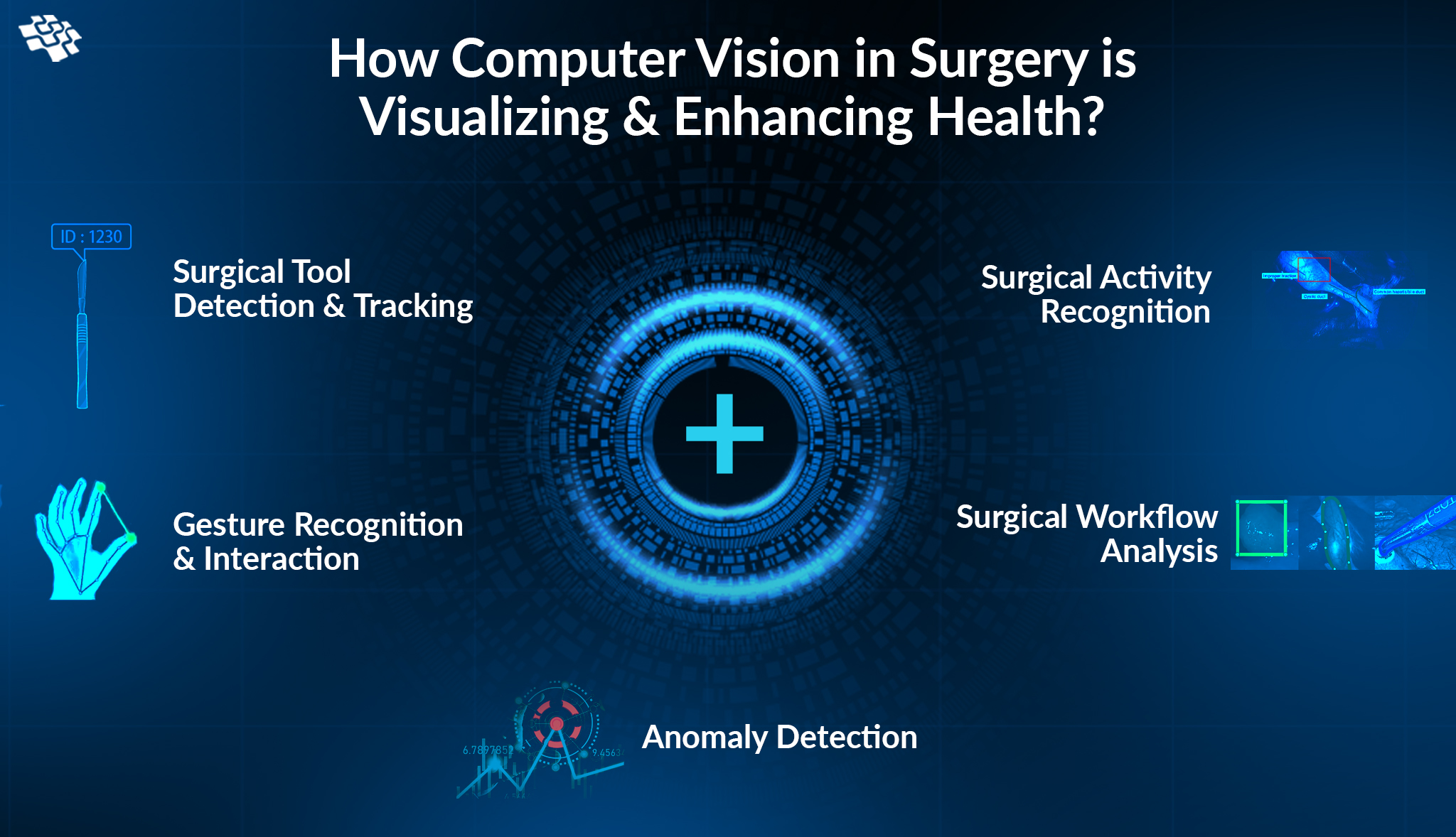Visualizing Health with the Power of Computer Vision in Surgery!
While humans tend to qualitatively assess images, CV provides a more objective and technical approach to surgical data interpretation. Computer vision in surgery is poised to revolutionize the field, ushering in a new era of precision and efficiency.

Tackle Surgical Challenges Head-on. Discover How Our Computer Vision Services Revolutionize Healthcare Precision

“The development and refining of deep neural networks that can now accurately identify objects in images and remember past surgical events has sparked a surge in the applications of computer vision to analyze intraoperative video and has allowed for the accurate identification of surgical phases (steps) and instruments across a variety of procedures.”- National Library of Medicine
Overview of Computer Vision
Computer vision in surgery encompasses the machine’s interpretation of visual data, including images and videos. It stands as a distinct discipline but tightly intertwines with machine learning, alongside related fields like image processing, signal processing, optics, and cognitive sciences such as psychology and neuroscience. While object detection and recognition have gained prominence in social media, the scope of computer vision extends far beyond. This expansive field focuses on characterizing and interpreting the visual world in numerical or symbolic representations, facilitating the analysis of images for consequential actions. In the context of surgery, computer vision extends this capability to the medical domain, enabling the numerical interpretation of intraoperative visual data. This not only enhances decision-making but also opens avenues for computer-assisted surgical procedures by extracting actionable insights from the surgical environment.
Computer Vision for Automated Performance in Surgery
Computer vision in surgery enables automated performance metrics, providing quantitative and objective evaluations of surgical skills. These metrics, beneficial for surgical education and quality enhancement, offer precise assessments of performance.
- Accuracy and Precision: Computer vision enables precise evaluation of surgical precision and accuracy. It assesses suturing/knotting accuracy and measures the distance between the surgeon’s tooltip and the target spot. These metrics identify areas for improvement, providing valuable insights into precision-focused surgical skill development.
- Proficiency in Tissue Manipulation: Computer vision algorithms analyze surgical instrument-tissue interactions, evaluating traction, tissue handling, and forces applied. This assessment minimizes tissue damage risk and gauges the surgeon’s proficiency in delicate tissue management, enhancing surgical precision.
- Procedural Adherence: Computer vision can compare surgical actions to established guidelines or standard procedures. It can assess adherence to predefined steps, identify deviations or omissions, and provide feedback on the consistency of surgical technique. This can be particularly useful for ensuring compliance with best practices and safety protocols.
How Computer Vision in Surgery is Visualizing & Enhancing Health
Computer vision in surgery enhances research, education, and quality assessment by extracting valuable insights from surgical videos. It offers diverse applications, contributing to the advancement of surgical practices through precise analysis and extraction of useful information for comprehensive improvement in the field.
 1. Surgical Tool Identification & Tracking
1. Surgical Tool Identification & Tracking
Computer vision techniques play a pivotal role in identifying and tracking surgical devices and tools. This capability extends to accurately tracing the trajectory of instruments, discerning instances of instrument exchanges, and comprehending the nuanced interactions among multiple tools deployed throughout a surgical procedure. The granular data extracted through instrument recognition and surgical process analysis facilitates a multifaceted enhancement of surgical techniques. By employing computer vision, the meticulous tracking of tool trajectories aids in understanding the dynamic spatial movements involved. Identification of instrument exchanges not only ensures procedural adherence but also allows for insights into the surgeon’s decision-making process. The comprehensive analysis of multiple tools utilized provides a holistic perspective, enriching both instrument recognition and surgical process analysis. This amalgamation of data contributes to the refinement and optimization of surgical procedures, fostering advancements in the field.
2. Gesture Recognition & Interaction
Within surgical videos, computer vision adeptly recognizes and interprets hand gestures and interactions between surgeons and patients. This technological capability serves as a valuable tool for delving into the human factors and team dynamics in surgical settings. By extracting nuanced information about communication patterns, teamwork dynamics, and ergonomic considerations within the surgical team, computer vision facilitates in-depth studies. The precision of computer vision in discerning hand gestures contributes to understanding non-verbal communication cues among surgical team members. Recognition of surgeon-patient interactions allows for insights into the intricacies of these crucial engagements during procedures. The extracted data provides a foundation for comprehensive studies on human factors, enabling a nuanced exploration of collaborative dynamics and ergonomic aspects within surgical teams. This amalgamation of information supports advancements in optimizing communication strategies, refining teamwork approaches, and enhancing overall surgical performance.
3. Real-time Surgery Assistance
Computer vision in surgery offers a transformative approach to assessing a surgeon’s technical proficiency through the analysis of surgical videos. Leveraging advanced algorithms, it objectively measures skill mastery by tracking and analyzing key elements such as tool movements, hand-eye coordination, and overall surgical performance. This data, providing precise and quantifiable metrics, becomes a cornerstone for quality improvement initiatives, constructive feedback mechanisms, and targeted training programs. The nuanced insights derived from computer vision analysis empower medical professionals with a comprehensive understanding of a surgeon’s capabilities. By delineating specific aspects of technique and performance, these objective measurements serve as valuable indicators for continuous improvement. Through this integration of technology, the surgical community gains a potent tool for refining surgical skills, fostering a culture of excellence, and advancing the overall quality of patient care through informed and data-driven training and feedback mechanisms.
4. Surgical Workflow Analysis
Utilizing computer vision in surgery, the examination of surgical recordings unveils insights into the sequential order of procedures and the overarching workflow. This technological application aids in pinpointing areas necessitating process enhancement, ensuring procedural uniformity, and optimizing surgical techniques. By extracting valuable data from surgical videos, computer vision becomes an instrumental tool in identifying opportunities for refining and streamlining surgical processes. This not only contributes to the standardization of procedures but also facilitates continuous improvement in surgical workflows, fostering a culture of precision and efficiency in the medical domain.
5. Anomaly Detection
An analysis of surgical recordings using computer vision detects unexpected or unusual events, such as aftereffects, deviations from the established surgical protocol, or unusual anatomical variations. This anomaly identification in surgical videos plays a crucial role in advancing patient safety, providing insights to prevent errors, and contributing to the investigation of adverse outcomes. By leveraging sophisticated algorithms, computer vision becomes a proactive tool in identifying deviations from the norm during surgical procedures. This not only enhances the understanding of potential risks but also empowers healthcare professionals with valuable information to mitigate unexpected events, fostering a proactive approach to patient safety and continuous improvement in surgical practices.
Benefits of Computer Vision in Surgery
- Precision and Accuracy: In surgical treatments, computer vision systems excel in precision, detecting structures, anomalies, and abnormalities. Their unparalleled accuracy reduces error margins, elevating surgical outcomes to the highest level of precision and efficacy. Computer vision in surgery thus emerges as a critical technology for advancing the accuracy and success of surgical procedures.
- Reduced Procedure Time: Real-time image analysis and 3D guidance enable surgeons to enhance speed and precision, minimizing patient exposure to the operating room environment. This technological integration not only accelerates procedures but also contributes to overall surgical effectiveness and patient care.
- Minimized Invasiveness: Increasingly, minimally invasive procedures, facilitated by computer vision, enhance healing and reduce scarring. Computer vision ensures a clear visualization of the surgical site, enabling precise interventions. This technological advancement not only promotes faster recovery but also minimizes the impact of surgery on patients, contributing to improved overall outcomes.
Challenges of Computer Vision in Surgery
- Data Privacy and Security: Ensuring robust data security is imperative when handling sensitive medical images to uphold patient confidentiality and comply with regulations like HIPAA. Stringent procedures are essential to safeguard the privacy and integrity of medical data, reflecting a commitment to maintaining the highest data protection standards in healthcare settings.
- Cost of Implementation: The integration of computer vision systems in medical facilities can incur significant costs, posing a potential barrier to access for smaller healthcare institutions. This financial consideration may limit the adoption of advanced computer vision technologies in certain healthcare settings.
- Continuous Learning: Sustaining relevance and utility in surgical contexts requires continual training and updating of machine learning algorithms, a crucial aspect of the ongoing efficacy of computer vision in surgery. Regular updates ensure these algorithms remain adaptive and applicable to evolving medical scenarios.
Future of Computer Vision in Surgery
The future of computer vision in surgery is promising. Anticipated advancements include enhanced technologies, further refining surgical precision, and expanding applications, marking a continuous evolution in surgical practices.
- Greater Accessibility: Potential advancements may lead to more cost-effective solutions, democratizing access to computer vision technology within the medical community. This increased affordability is likely to broaden the utilization of advanced computer vision tools among a diverse range of medical professionals.
- Enhanced Surgical Procedures: The evolution of computer vision technology is poised to significantly impact intricate surgical procedures, with expanding applications anticipated in neurosurgery and orthopedics. This advancement signifies a growing role for computer vision in enhancing precision and outcomes across specialized surgical domains.
- Improved Diagnostics: Enhanced picture recognition capabilities, facilitated by computer vision in healthcare, will expedite and enhance diagnostic accuracy. This advancement enables the development of personalized treatment plans and early disease identification, marking a significant stride toward more effective and tailored healthcare interventions.
The integration of computer vision in surgery heralds a transformative era, enhancing precision and visualizing health in unprecedented ways. As surgical landscapes evolve, the potential for improved outcomes and enhanced patient care is immense. Explore the forefront of innovation with NextGen Invent, empowering medical professionals through innovative computer vision services.
Contact us today to explore how our advanced computer vision solutions can revolutionize your healthcare practices.
Related Blogs

Computer Vision in Healthcare: Transformation is Here
Within healthcare, the efforts of medical professionals play a pivotal role and have a direct impact on patients’ well-being. Advanced computer vision in healthcare technologies, particularly in object recognition, empowers physicians with an unmatched ability to focus and keenly observe critical details.

Technological Advancements for Early Detection of Breast Cancer
AI in ultrasound technology has shown a remarkable accuracy rate of over 90% in detecting breast cancer in its early stages. These statistics highlight the technology’s effectiveness in identifying subtle abnormalities, often undetectable through traditional screening methods.

Deep Learning for Computer Vision: The Ultimate Expert Guide
Social networking, autonomous driving, healthcare, and security are just a few of the areas that have been transformed by deep learning for computer vision. The advent of powerful deep learning architectures has been pivotal in processing visual input, reshaping these sectors.
Stay In the Know
Get Latest updates and industry insights every month.
 1. Surgical Tool Identification & Tracking
1. Surgical Tool Identification & Tracking